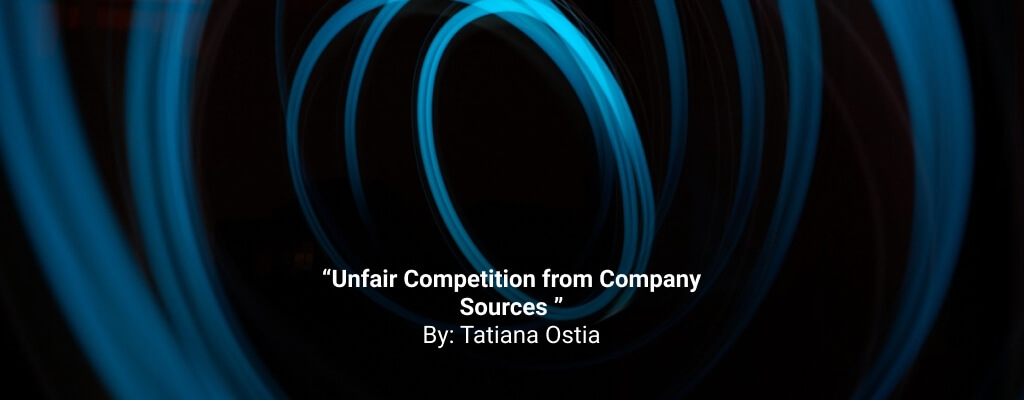12 DE FEBRERO DE 2021

| By: Tatiana Ostia |
Undoubtedly, this is a topic that many of us find familiar, especially if we are in charge of a company, however, the tendency is to think that it is the competition that comes from our commercial adversaries, however, on this occasion, we will refer to that competence that arises from within our own organization.
The first thing to understand is that no competition that arises from our own corporate or work environment will be fair since a competition that is based on our own information and with our own resources can never be legitimate. The focus of our attention, then, is that competition made, on the one hand, by our own employees, managers and collaborators or by our contractors, sub-contractors or suppliers on the other. – Of course, the purpose of this approach to the problem is to conclude with suggestions that help us to prevent it.
If we accept the fact that our employees handle information from our operation and that the higher the rank they have, the more sensitive that information will be, we will then have to accept that any employee has the potential to take advantage of that information to compete against us, which worsens even more if the information compromises the flow, the logistics or information with which we have managed to position our product or service, an effort that has unequivocally involved investment of resources, time and money in order to achieve the value of the product that we long to have.
Once the risk is considered and confirmed, we then have to analyze the possible sources of it, in which case, our professional experience leads us to say that there are two sources of this contingency, on the one hand the workforce and on the other our suppliers, contractors and subcontractors, sources that depending on the nature of our business will have more relevance one than the other, since for example, for a product distribution and representation company, the risk in relation to its employees is greater and more important, while for a company service company, its suppliers and contractors represent equal or greater risk than its collaborators, therefore, in all cases, both segments must be addressed.
¿But? How the damage materializes
Generally, we limit ourselves to thinking that the use of relevant information in an unauthorized way (to sell it or use it for personal gain) is the way in which unfair competition is executed, however, there are several ways in which an employee or a contractor can use that information against us, let’s look at some examples.
An employee who knows our prices and their margins can easily offer their clients the same products or services at lower prices with the aim of creating their own clientele, as would, for example, a systems provider who has access to accounting information, of billing or customer relations, this practice is known as “acts of customer deviation” since it may happen that it is done for the benefit of the same that uses the information or of a third party in exchange for an economic benefit (as a reference think that a CRM or fiscal printer vendor will generally have access to your customer list). A subcontractor who knows your organization can easily offer a better salary to an employee of your company who represents a valuable human asset for you, in order to achieve not only that it works for you but also as a very broad source of all the information that already exists. acquired, being then that our company absorbed the cost of learning and another will benefit from what was learned, this is known as “acts of disorganization”. As well as these there are many other malicious acts that imply unfair competition, such as acts of confusion, deception, comparison, imitation that are means that seek to specify the contractual breach that we have with our clients through the unfavorable comparison of our products or services or its imitation.
Although the Law penalizes certain acts like these, almost all of them are focused on the unauthorized use of privileged information, so a fairly effective alternative is prevention.
If we consider that it is not feasible to restrict information to those who must necessarily know it, then prevention, through the promise of criminal and economic sanction, becomes an excellent and effective tool to minimize risks. The reality is that sometimes the message that is sent to employees and suppliers that they are fully aware of the possibility that their information may be used illegally serves a deterrent effect as it is certainly discouraging. On the other hand, the promise of a criminal and economic sanction in the event that we face an employee or a supplier who executes these acts is more effective than taking reparative actions, that is, prevention works better than reparation, since that it is very likely that a criminal or financial sanction will not be enough to repair damage due to information leakage and sometimes, even if we finally achieve a conviction, that does not mean that we can actually carry it out.
Having an information management policy and standardized procedures for hiring employees and suppliers is a necessary action that should not be omitted in any organization, especially if we consider that technology, social networks and information management operate against us. Have formal documents of legal connotation that oblige an employee to compensate a training or to refrain from certain behaviors under penalty of legal and labor sanctions or that force a contractor to compensate the damages caused if by fault or fraud he uses the information apprehended in the exercise of the service provided to us, guarantees us that if we face this situation, our claim and our actions will be duly supported on a contractual basis that we would not have if we lacked these elements of conviction that in themselves are generators of a type of direct liability other than those often uncertain claims that are based on tort liability.


